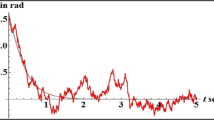Abstract
Magnetotactic microorganisms can be found as unicellular prokaryotes, as cocci, vibrions, spirilla and rods, and as multicellular organisms. Multicellular magnetotactic prokaryotes are magnetotactic microorganisms composed by several magnetotactic bacteria organized almost in a spherical helix, and one of the most studied is Candidatus Magnetoglobus multicellularis. Several studies have shown that Ca. M. multicellularis displays forms of behavior not well explained by magnetotaxis. One of these is escape motility, also known as “ping-pong” motion. Studies done in the past associated the “ping-pong” motion to some magnetoreceptive behavior, but those studies were never replicated. In the present manuscript a characterization of escape motility trajectories of Ca. M. multicellularis was done for several magnetic fields, considering that this microorganism swims in cylindrical helical trajectories. It was observed that the escape motility can be separated into three phases: (I) when the microorganism jumps from the drop border, (II) where the microorganism moves almost perpendicular to the magnetic field and (III) when the microorganism returns to the drop border. The total time of the whole escape motility, the time spent in phase II and the displacement distance in phase I decreases when the magnetic field increases. Our results show that the escape motility has several characteristics that depend on the magnetic field and cannot be understood by magnetotaxis, with a magnetoreceptive mechanism being the best explanation.






Similar content being viewed by others
References
Abreu F, Acosta-Avalos D (2018) Biology and physics of magnetotactic bactéria. In: Blumenberg M, Shaaban M, Elgaml A (eds) Microorganisms. IntechOpen, London. https://doi.org/10.5772/intechopen.79965
Abreu F, Martins JL, Silveira TS, Keim CN, Lins de Barros HGP, Gueiras-Filho F, Lins U (2007) ‘Candidatus Magnetoglobus multicellularis’, a multicellular magnetotactic prokaryote from a hypersaline environment. Int J Syst Evol Microbiol 57:1318–1322
Acosta-Avalos D, Rodrigues E (2019) On the motion of magnetotactic bacteria: theoretical predictions and experimental observations. Eur Biophys J 48:691–700
Acosta-Avalos D, Azevedo LMS, Andrade TS, Lins de Barros H (2012) Magnetic configuration model for the multicellular magnetotactic prokaryote Candidatus Magnetoglobus multicellularis. Eur Biophys J 41:405–413
Almeida FP, Viana NB, Lins U, Farina M, Keim CN (2013) Swimming behavior of the multicellular magnetotactic prokaryote ‘Candidatus Magnetoglobus multicellularis’ under applied magnetic fields and ultraviolet light. Antonie van Leewenhoek 103:845–857
Bente K, Mohammadinejad S, Charsooghi MA, Bachmann F, Codutti A, Lefevre CT, Klumpp S, Faivre D (2020) High-speed motility originates from cooperatively pushing and pulling flagella bundles in bilophotrichous bacteria. eLife 9:e47551
Blakemore RP (1982) Magnetotactic bacteria. Ann Rev Microbiol 36:217–238
De Melo RD, Acosta-Avalos D (2017a) Light effects on the multicellular magnetotactic prokaryote ‘Canditatus Magnetoglobus multicellularis’ are cancelled by radiofrequency fields: the involvement of radical pair mechanisms. Antonie Van Leeuwenhoek 110:177–186
De Melo RD, Acosta-Avalos D (2017b) The swimming polarity of multicellular magnetotactic prokaryotes can change during and isolation process employing magnets: evidence of a relation between swimming polarity and magnetic moment intensity. Eur Biophys J 46:533–539
De Melo RD, Leão P, Abreu F, Acosta-Avalos D (2020) The swimming orientation of multicellular magnetotactic prokaryotes and uncultured magnetotactic cocci in magnetic fields similar to the geomagnetic field reveals differences in magnetotaxis between them. Antonie Van Leeuwenhoek 113:197–209
Greenberg M, Canter K, Mahler I, Torheim A (2005) Observation of magnetoreceptive behavior in a multicellular magnetotactic prokaryote in higher than geomagnetic fields. Biophys J 88:1496–1499
Kalmijn AJ (1981) Biophysics of geomagnetic field detection. IEEE Trans Magn MAG 17:1113–1124
Keim CN, Martins JL, Lins de Barros H, Lins U, Farina M (2006) Structure, behavior, ecology and diversity of multicellular magnetotactic prokaryotes. In: Schuler D (ed) Magnetoreception and magnetosomes in bacteria. Springer, Berlin, pp 103–132. https://doi.org/10.1007/7171_04
Keim CN, de Melo RD, Almeida FP, Lins de Barros HGP, Farina M, Acosta-Avalos D (2018) Effect of applied magnetic fields on motility and magnetotaxis in the uncultured magnetotactic multicellular prokaryote ‘Candidatus Magnetoglobus multicellularis’. Environ Microbiol Rep 10(4):465–474
Lefevre CT, Bennet M, Landau L, Vach P, Pignol D, Bazylinski DA, Frankel RB, Klumpp S, Faivre D (2014) Diversity of magneto-aerotactic behaviors and oxygen sensing mechanisms in cultured magnetotactic bacteria. Biophys J 107:527–538
Lins U, Freitas F, Keim CN, Lins de Barros H, Esquivel DMS, Farina M (2003) Simple homemade apparatus for harvesting uncultured magnetotactic microorganisms. Braz J Microbiol 34:111–116
Silva KT, Abreu F, Almeida FP, Keim CN, Farina M, Lins U (2007) Flagellar apparatus of South-seeking many-celled magnetotactic prokaryotes. Microsc Res Technol 70:10–17
Yan L, Zhang S, Chen P, Liu H, Yin H, Li H (2012) Magnetotactic bacteria, magnetosomes and their application. Microbiol Res 167:507–519
Acknowledgements
The present research was done during the 4th Advanced School of Experimental Physics (4th EAFExp) organized by Centro Brasileiro de Pesquisas Físicas (CBPF) in February 2019. V Sudbrack, KPT Huamani, KS Berbereia and LCS Lopes acknowledge the EAFExp organizing committee for financial support. V Sudbrack acknowledges financial support from FAPESP (process 2018/23984-0). HOL Mota acknowledges financial support from the Physics Department of Universidade Federal de Viçosa. Special thanks to Dr. Carolina N. Keim for her helpful comments.
Author information
Authors and Affiliations
Corresponding author
Ethics declarations
Conflict of interest
The authors declare no conflict of interest.
Additional information
Publisher's Note
Springer Nature remains neutral with regard to jurisdictional claims in published maps and institutional affiliations.
Rights and permissions
About this article
Cite this article
Sepulchro, A.G.V., de Barros, H.L., de Mota, H.O.L. et al. Magnetoreception in multicellular magnetotactic prokaryotes: a new analysis of escape motility trajectories in different magnetic fields. Eur Biophys J 49, 609–617 (2020). https://doi.org/10.1007/s00249-020-01467-4
Received:
Revised:
Accepted:
Published:
Issue Date:
DOI: https://doi.org/10.1007/s00249-020-01467-4




